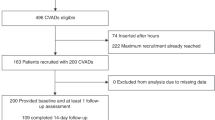Abstract
Background-Aim
Central venous catheters (CVC) can be used for mid and long-term venous access allowing administration, monitoring and haemodialysis. The objective of our study is to compare the complications from the insertion of dialysis CVC to those arising from insertion of CVC for other use.
Materials and Methods
We retrospectively evaluated the positioning of 285 dual lumen 12Fr CVCs for haemodialysis [Group P1] and 520 three lumen 6Fr catheters [Group P2] from January 2008 to February 2010. All CVCs were positioned by our vascular access team. We compared vein selection, efficacy in positioning, early and late complications.
Results
In both groups, the subclavian vein was principally chosen for catheterization. Positioning failed in 7 patients group (P1), while in P2 all CVCs were positioned successfully. Early complications presented in 9 patients from group (P1) (3.1%) and in 12 from group P2 (2.3%). In group P1, 4 cases of CVC-related infection were reported for every 1000 days of use as opposed to 15 cases in group P2.
Conclusions
The diverse types of CVC devices involve comparable rates of complications; although the larger diameter of dialysis catheters reduces the risk of malposition, it increases the rate of site injuries. Fewer late complications were reported for dialysis catheters, which may be attributed to their highly specialized use.
Similar content being viewed by others
References
National Kidney Foundation, Clinical Practice Guidelines and Clinical Practice Recommendations. Clinical Practice Guideline for vascular access. [Online].; 2006 http://www.kidney.org/Professionals/kdoqi/guideline upHD PD VA/va guide8.htm.
Pittiruti M, Hamilton H, Biffi R, MacFie J, Pertkiewicz M. ESPEN Guidelines on Parenteral Nutrition: central venous catheters (access, care, diagnosis and therapy of complications). Clin Nutr. 2009; 28: p. 365–377.
Gabriel J, Bravery K, Dougherty L, Kayley J, Malster M, Scales K. Vascular access: indications and implications for patient care. Nurs Stand. 2005; 19: p. 45–52.
Arenas-Marquez H, Anaya-Prado R, Barrera-Zepeda LM, Gonzalez-Ojeda A. Complications of central venous catheters. Curr Opin Clin Nutr Metab Care. 2001; 4: p. 207–210.
Maroulis J, Kalfarentzos F. Complications of parenteral nutrition at the end of the century. Clin Nutr. 2000; 19: p. 295–304.
Sitzmann JV, Townsend TR, Siler MC, Bartlett JG. Septic and technical complications of central venous catheterization. A prospective study of 200 consecutive patients. Ann. Surg. 1985; 202: p. 766–770.
Barie P, Eachempati S. Monitoring of Respiratory Function and Weaning from Mechanical Ventilation. In Bland KI, Sarr MG, Büchler MW, Csendes A, Garden OJ, Wong J. General Surgery: Principles and International Practice.: WB Saunders, UK, 2002; 2009. p. 188.
Merrer J, De Jonghe B, Golliot F, Lefrant JY, Raffy B, Barre E, et al. Complications of femoral and subclavian venous catheterization in critically ill patients: a randomized controlled trial. JAMA. 200; 286: p. 700–707.
Sznajder JI, Zveibil FR, Bitterman H, Weiner P, Bursztein S. Central vein catheterization. Failure and complication rates by three percutaneous approaches. Arch. Intern. Med. 1986; 146: p. 259–261.
Mansfield PF, Hohn DC, Fornage BD, Gregurich MA, Ota DM. Complications and failures of subclavian-vein catheterization. N. Engl. J. Med. 1994; 331: p. 1735–1738.
Martin C, Eon B, Auffray JP, Saux P, Gouin F. Axillary or internal jugular central venous catheterization. Crit. Care Med. 1990; 18: p. 400–402.
Durbec O, Viviand X, Potie F, Vialet R, Albanese J, Martin C. A prospective evaluation of the use of femoral venous catheters in critically ill adults. Crit. Care Med. 1997; 25: p. 1986–1989.
Timsit JF, Bruneel F, Cheval C, Mamzer MF, Garrouste-Orgeas M, Wolff M, et al. Use of tunneled femoral catheters to prevent catheter-related infection. A randomized, controlled trial. Ann. Intern. Med. 1999; 130: p. 729–735.
Hughes DB, Ullery BW, Spigland N. Formation of a calcified cast in a long-term indwelling central venous catheter: a case report. J. Pediatr. Surg. 2006; 41: p. 1927–1929.
Veenstra DL, Saint S, Saha S, Lumley T, Sullivan SD. Efficacy of antiseptic-impregnated central venous catheters in preventing catheter-related bloodstream infection: a meta-analysis. JAMA. 1999; 281: p. 261–267.
Raad I, Darouiche R, Dupuis J, Abi-Said D, Gabrielli A, Hachem R, et al. Central venous catheters coated with minocycline and rifampin for the prevention of catheter-related colonization and bloodstream infections. A randomized, double-blind trial. The Texas Medical Center Catheter Study Group. Ann. Intern. Med. 1997; 127: p. 267–274.
Heard SO, Wagle M, Vijayakumar E, McLean S, Brueggemann A, Napolitano LM, et al. Influence of triple-lumen central venous catheters coated with chlorhexidine and silver sulfadiazine on the incidence of catheter-related bacteremia. Arch. Intern. Med. 1998; 158: p. 81–87.
McKinley S, Mackenzie A, Finfer S, Ward R, Penfold J. Incidence and predictors of central venous catheter related infection in intensive care patients. Anaesth Intensive Care. 1999; 27: p. 164–169.
Lee T, Barker J, Allon M. Tunneled catheters in hemodialysis patients: reasons and subsequent outcomes. Am. J. Kidney Dis. 2005; 46: p. 501–508.
Jaber BL. Bacterial infections in hemodialysis patients: pathogenesis and prevention. Kidney Int. 2005 Jun; 67: p. 2508–2519.
Timsit JF, Farkas JC, Boyer JM, Martin JB, Misset B, Renaud B, et al. Central vein catheter-related thrombosis in intensive care patients: incidence, risks factors, and relationship with catheter-related sepsis. Chest. 1998; 114: p. 207–213.
Author information
Authors and Affiliations
Corresponding author
Rights and permissions
About this article
Cite this article
Kotsikoris, I., Zygomalas, A., Tzorbatzoglou, I. et al. Central venous haemodialysis catheter insertion. Is there any difference to the insertion of central venous catheters for other use?. Hellenic J Surg 83, 121–125 (2011). https://doi.org/10.1007/s13126-011-0025-2
Received:
Accepted:
Published:
Issue Date:
DOI: https://doi.org/10.1007/s13126-011-0025-2




